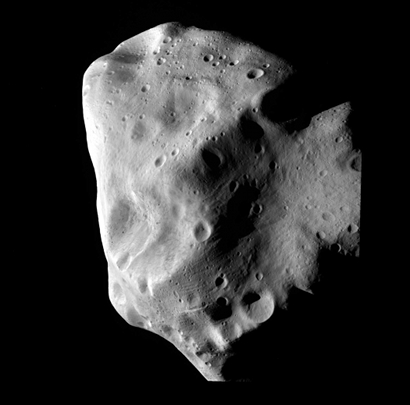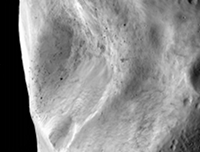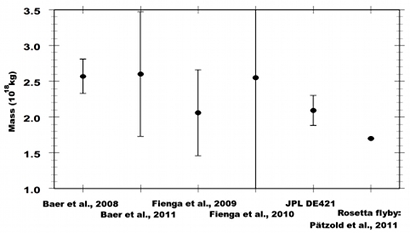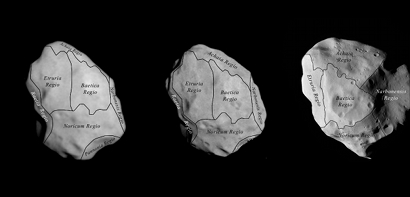Rosetta reveals mysterious Lutetia
27 October 2011
On 10 July 2010, ESA's Rosetta spacecraft flew past asteroid (21) Lutetia, one of the largest objects orbiting within the main asteroid belt between Mars and Jupiter. Rosetta's encounter revealed an intriguing object which has survived since the birth of the planets, some 4.5 billion years ago.Discovered in 1852, Lutetia was among the first objects to be classified as an M-type (metallic) asteroid, but radar observations revealed an unusually low albedo, or reflectivity, that was inconsistent with a metallic surface. Meanwhile, spectra obtained at visible and infrared wavelengths found similarities with meteorites known as enstatite chondrites and with carbonaceous chondrite meteorites, typically associated with C-type asteroids.
Since there was no consensus on the correct interpretation of its largely featureless spectrum, the Rosetta science team was delighted to have the opportunity to examine the enigmatic object during the spacecraft's second passage through the asteroid belt.
 |
|
Asteroid (21) Lutetia at closest approach, on 10 July 2010. |
The flyby of Lutetia took place on 10 July 2010, when Rosetta sped past the huge chunk of rock at a distance of 3170 km. The scientific results of this encounter are summarised in three papers published this week in the journal Science.
As Rosetta closed on the rotating asteroid, the OSIRIS imaging system returned 462 pictures of the illuminated northern hemisphere, showing more than 50 per cent of the asteroid's surface.
More than 350 craters were identified with diameters between 600 metres and 55 km and depths of up to 10 km. However, the crater density varied considerably – the regions with the largest number of craters were clearly older than those with fewer craters.
"By counting the craters, we determined that the surface of Lutetia is about 3.6 billion years old," said Holger Sierks from the Max-Planck-Institut für Sonnensystemforschung in Germany, lead author of the OSIRIS paper in Science. "It was probably almost spherical before large amounts of material were removed by impacts."
 |
|
Landslides and boulders can be seen in this large crater in the Baetica region of Lutetia. |
Some craters have been partially or completely buried by huge landslides. Several hundred boulders up to 300 metres across - probably impact debris - were also identified. These were among the largest rocks found so far on small bodies in the Solar System.
Variations in albedo were visible in the younger Baetica region, while the older Achaia region appeared very uniform in brightness. Landslides and exposed, rocky outcrops in Baetica had an increased albedo compared to their surroundings, suggesting that 'weathering' by incoming solar radiation, micrometeorites and high energy particles has darkened the older surfaces.
OSIRIS also revealed a vast network of grooves, fractures and grabens (rift valleys), which are similar in appearance to those on the Martian moon Phobos. Several craters were cut by linear features, including one faulted valley structure in the Noricum region which was more than 10 km long and roughly 100 metres deep.
Further insights into the nature of Lutetia's surface were provided by the Visible, InfraRed and Thermal Imaging Spectrometer (VIRTIS), which obtained hyperspectral images, spectral reflectance maps and temperature maps of the asteroid.
Analysis of the VIRTIS hyperspectral data showed a remarkable uniformity in the surface spectral properties. This implied that the variations in albedo observed by OSIRIS must be related to transport and/or sorting of fragmented surface material, rather than variations in composition.
"No spectral evidence for silicates, hydrated minerals or water was found, demonstrating that Lutetia's surface materials have not been subjected to aqueous alteration," said Fabrizio Capaccioni of the Istituto di Astrofisica Spaziale e Fisica Cosmica in Rome, Italy, co-author of the VIRTIS paper in Science. "Lutetia's featureless spectrum does not enable its surface to be correlated with specific meteorites. However, the shape of the spectrum can be associated with either iron-rich carbonaceous chondrites or enstatite chondrites."
VIRTIS also determined that the asteroid's surface temperature varied between 170 K and 245 K (-103 °C to -28 °C), with the highest temperatures in regions where the Sun was high above the local horizon and on Sun-facing slopes. The data suggest that the surface is covered by a layer of dust particles in the 50 to 100 micron size range. When combined with the observed spectral uniformity across the surface, this indicated the presence of an extensive and uniform regolith cover, comparable to the powdery 'soil' on the Moon.
NASA's Deep Space Network 70-metre antenna near Madrid, Spain, was used to track the spacecraft during the flyby, and Rosetta's radio science observations provided important clues to the asteroid's composition and internal structure. Analysis of the Doppler shift in the radio signals received back on Earth showed how the velocity of the spacecraft was modified by the asteroid's weak gravity. These observations were made from four hours before to six hours after closest approach.
 |
|
Measurements obtained during the Rosetta flyby of Lutetia have resulted in the most precise determination of the mass of the asteroid to date. Image courtesy of M. Pätzold. |
The Doppler data enabled the science team to determine the mass of Lutetia with greater precision than ever before. With a value of
"Spacecraft tracking during a close flyby is by far the most accurate method to determine an object's mass," said Martin Pätzold of the Rheinisches Institut für Umweltforschung at the University of Cologne, lead author of the Radio Science Investigation paper in Science. "Our data show that the previous mass estimates derived from ground-based techniques were systematically too high."
"Although only half of Lutetia has yet been imaged, so its precise shape is not yet known, we can say that the asteroid's bulk density is unexpectedly high. In fact, it has one of the highest densities of any known asteroid," added Sierks.
Assuming that Lutetia has a modest internal porosity, its high density probably indicates that it is enriched in metallic elements such as iron. It may also be evidence of partial differentiation of the asteroid's interior, early in its history, with an unmelted chondritic surface overlying a higher density interior which was once molten. This is consistent with the spectral data, which support a composition similar to iron-rich carbonaceous or enstatite chondrites.
The Rosetta data indicate that Lutetia is probably a primordial planetesimal, one of the building blocks from which the planets were born 4.5 billion years ago. Having survived numerous impacts, Lutetia can be regarded as an important missing link between smaller asteroids, which are often shattered rubble piles, and terrestrial planets such as Earth.
"This is a crucial step in understanding the asteroid belt," said Rita Schulz, ESA's Rosetta Project Scientist. "Having seen several members of the belt in the past that were all different in their own ways, we have now found a large and rather primordial body. Clearly, there is still much more to investigate before we understand the belt fully."
"The excellent scientific results of Rosetta's two asteroid encounters (Lutetia and Steins) also show how important it is – when possible – to add asteroid flybys to any mission," she added.
Reference publications
H. Sierks, et al., "Images of Asteroid 21 Lutetia: A Remnant Planetesimal from the Early Solar System", 2011, Science, Vol. 334, No. 6055, pp. 487-490. DOI: 10.1126/science.1207325
M. Pätzold, et al. "Asteroid (21) Lutetia - Low Mass, High Density", 2011, Science, Vol. 334, No. 6055, pp. 491-492. DOI: 10.1126/science.1209389
A. Coradini, F. Capaccioni, et al., "The Surface Composition and Temperature of Asteroid 21 Lutetia as observed by ROSETTA/VIRTIS", 2011, Science, Vol. 334, No. 6055, pp. 492-494. DOI: 10.1126/science.1204062
Contacts
Holger Sierks
Max-Planck-Institut für Sonnensystemforschung,
Katlenburg-Lindau, Germany
Phone: +49 5556 979 242
Email: Sierks mps.mpg.de
mps.mpg.de
Fabrizio Capaccioni
Istituto di Astrofisica Spaziale e Fisica Cosmica – INAF
Rome, Italy
Phone: +39 06 4993 4183
Email: fabrizio.capaccioni iasf-roma.inaf.it
iasf-roma.inaf.it
Martin Pätzold
Rheinisches Institut für Umweltforschung, Abteilung Planetenforschung
Universität zu Köln, Germany
Phone: +49-221-27781810
Email: Martin.Paetzold uni-koeln.de
uni-koeln.de
Rita Schulz, ESA Rosetta Project Scientist
Research and Scientific Support Department
Directorate of Science and Robotic Exploration, ESA, The Netherlands
Phone: +31-71-565-4821
Email: rschulz rssd.esa.int
rssd.esa.int





